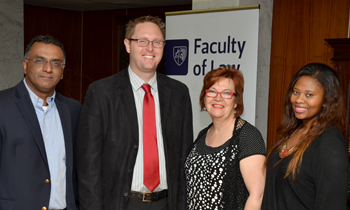 Representatives of the US Embassy in South Africa and other stakeholders gathered in Bloemfontein in November 2014. From the left are: San Reddy and Chad Wessen from the US Embassy, Prof Beatri Kruger, and Palesa Mafisa, Chairperson of the Kovsie National Freedom Network. |
Human trafficking is a multi-billion dollar ‘business’ with daunting challenges because of the uniqueness and complexities involved in the crime, says Prof Beatri Kruger, ex-prosecutor and lecturer in Criminal Law in the Faculty of Law.
Prof Kruger’s on-going research concentrates on whether South Africa’s legal efforts to combat human trafficking complies with international standards set out in the United Nations Trafficking Protocol of 2000 and other relevant international treaties.
Since the completion of her studies, the Prevention and Combatting of Trafficking in Persons Act of 2013 was passed in Parliament, but needs to be promulgated. This means South Africa is still a long way from complying with the UN protocol. A delegation of the US Embassy in South Africa recently visited the Faculty of Law on the Bloemfontein Campus. The purpose of their visit was to gain information for the US Department of State’s comprehensive 2015 report on trafficking in persons.
Prof Kruger’s current research focuses on the new legislation in collaboration with other national and international stakeholders. One of the focus areas is how traffickers control their victims. This research enhances the understanding of why victims often do not seek help, do not want to be ‘rescued’ and why they return to the very traffickers who have brutally exploited them.
The recently released Global Slavery Index 2014 estimates that 36 million people are living as slaves worldwide and that 106 000 of them are in South Africa. This report states that ‘modern slavery’ includes human trafficking, forced labour, forced marriage, debt bondage and the sale of children. The International Labour Organization estimates the illicit profits of forced labour to be US $150 billion a year.